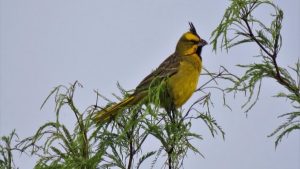The Ministry of Environment, in collaboration with the San Juan Police, carried out an operation to rescue 20 yellow cardinals that were destined for illegal trade in the province. After being rescued, these birds were sent to a local rehabilitation center to be transferred to the Temaikén Foundation in Buenos Aires, where they will complete their recovery before being released into their natural habitat.
In addition to the rescue, the Ministry of Environment pointed out the five departments that function as the main hotspots for illegal wildlife trafficking: Ullum, 9 de Julio, Zonda, San Martín, and 25 de Mayo. These places, especially those near provincial borders, are key entry points for trafficked species, some originating from other regions.
The Conservation Director, in an interview with a local media outlet, explained that the yellow cardinals were rehabilitated at the Tierras Blancas farm before being transferred to the Temaikén Foundation, to be part of the national program for the conservation of this species. “The goal is to complete their rehabilitation and return them to their natural environment,” stated the specialist.
Illegal wildlife trafficking is a serious problem in the region, especially in departments like Ullum and 9 de Julio, where bird trading is more common. For this reason, authorities are collaborating with neighboring provinces to strengthen actions against this crime.

Illegal animal trade, one of the main causes of extinction
The illegal sale of animals is one of the main threats to species. As a result, the local government has implemented several training programs for security forces, in order to improve their capacity to act in these cases. “Constant controls are being carried out and joint efforts between wildlife agents and security forces are being made to combat illegal animal trafficking,” concluded the Conservation Director.
According to the Convention on International Trade in Endangered Species of Wild Fauna and Flora (CITES), illegal animal trafficking is a crime that involves capturing, selling, buying, extracting, and unauthorized possession of wild species or their derivatives. It is also an illicit business and one of the most profitable in the world, after drug and arms trafficking.
Among the consequences of animal trafficking are the risk to the survival of endangered species, the destruction of countries’ natural wealth, human health, the economic and social development of communities, and it also helps finance terrorism.
Have you visited our YouTube channel yet? Subscribe now!

